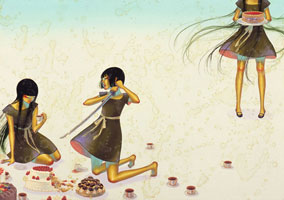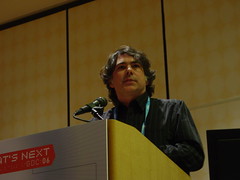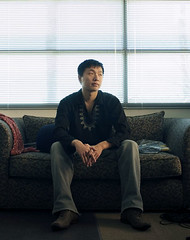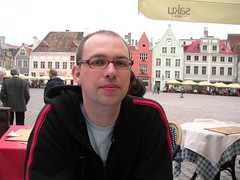
Chris Bateman is the designer behind Discworld Noir, Ghost Master, Heretic Kingdoms: The Inquisition and many others (videogames as well as board games). With the exception of the independently developed Play with Fire, he works mostly as a designer “pur sang” in the sense that he seldom initiates a project or comes up with the basic themes for a game but instead works in a much more applied fashion, like a furniture designer would or a fashion designer. We hired him ourselves in that capacity when we were working on “8” and he did a spectacular job, saving us from having to design the actual gameplay ourselves (which, as you may know, is something we detest 😉 ).
That being said, by now, Mr. Bateman is probably much better known as a provocative games theorist, philosopher and even economic analyst on his fascinating blog Only a Game. He’s currently finishing up his second book on game design. But it is reading his first book “21st Century Game Design” that prompted this interview. In this book Chris Bateman and Richard Boon map the play behaviour of different people to their psychological profiles and come to the conclusion that different people play in different ways. As logical as this may sound, it is one of the most ignored aspects of the medium in the videogames industry. So much so that one company who recognized this was able to outclass and outsell two other companies while they were comparing the size of their consoles and with products that were technically inferior. That company was Nintendo and the success of its strategy was predicted by Mr Chris Bateman.
To learn why there’s more to videogames than first person shooters, what the commercial opportunities are in experimental games and why the Sims and Grand Theft Auto remain unrivaled and unparalleled:
 In April 2009, we had the honor of interviewing Japanese artist Fuco Ueda, thanks to Miss Ellie Nagata’s kind offer to translate. Miss Ueda’s work has been a great source of inspiration and strength when we were creating The Path, as her work also seems to deal with the pleasure and pain of being a girl. In a way, the Red Girls are some kind of estranged cousins of the skinny contemporary nymphs in the pictures by Fuco Ueda. So it’s only appropriate that it’s our girls who do the questioning in the interview.
In April 2009, we had the honor of interviewing Japanese artist Fuco Ueda, thanks to Miss Ellie Nagata’s kind offer to translate. Miss Ueda’s work has been a great source of inspiration and strength when we were creating The Path, as her work also seems to deal with the pleasure and pain of being a girl. In a way, the Red Girls are some kind of estranged cousins of the skinny contemporary nymphs in the pictures by Fuco Ueda. So it’s only appropriate that it’s our girls who do the questioning in the interview.






 Alex Mayhew is an artist. It is not often one gets to say this about somebody who works in interactive media. But he is one of those very few whom we can call an artist without ifs or buts. As such, the conceptual limitations of game design don’t mean much to him. He designs straight for the core of the matter: interactivity and you, the user. This doesn’t stop him from going on about fishing on the Wii or playing Loco Roco, though.
Alex Mayhew is an artist. It is not often one gets to say this about somebody who works in interactive media. But he is one of those very few whom we can call an artist without ifs or buts. As such, the conceptual limitations of game design don’t mean much to him. He designs straight for the core of the matter: interactivity and you, the user. This doesn’t stop him from going on about fishing on the Wii or playing Loco Roco, though.